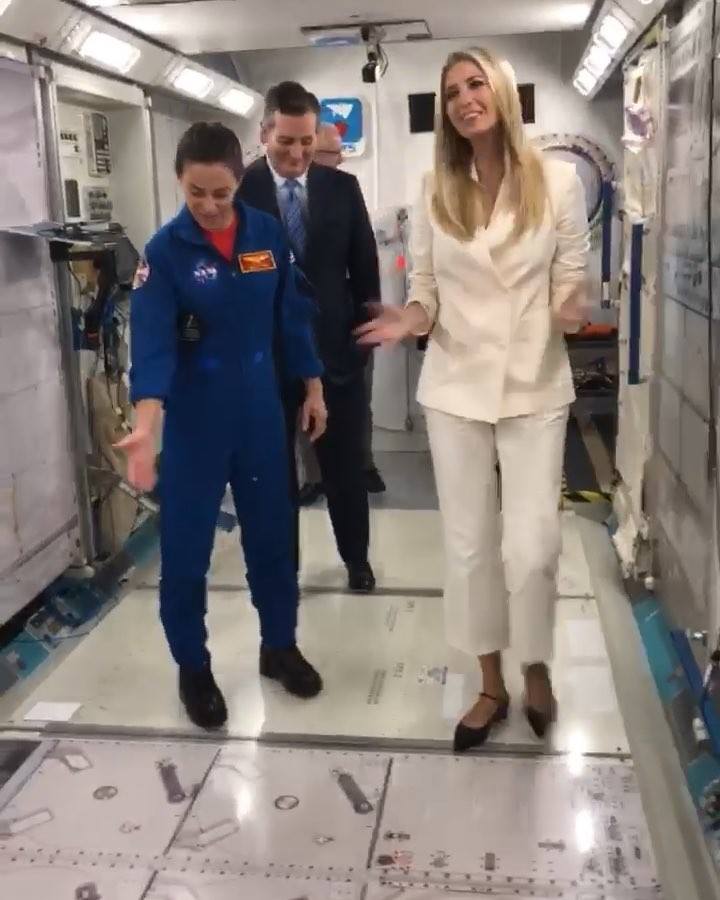Ivanka’s visit to NASA.
Great day at @nasa’s Johnson Space Center with Administrator @jimbridenstine checking out new tech + innovations and meeting with students, our future scientists and astronauts, who will bring us back to the moon 🌙 🚀.

Ivanka’s visit to NASA.
Great day at @nasa’s Johnson Space Center with Administrator @jimbridenstine checking out new tech + innovations and meeting with students, our future scientists and astronauts, who will bring us back to the moon 🌙 🚀.
At the same time as the hardware for SpaceX’s first BFR spaceship is entering the early stages of manufacturing, the company’s South Texas test facility is slowly taking shape after more than 18 months of what can be fairly described as hibernation.
The likeliest location for a near-future spaceship test stand or pad has also experienced a comparatively vast influx of construction workers and general activity that began earlier this month September, nearly two and half years after SpaceX began preparing the unstable coastal wetland with the addition of several hundred tons of soil.
Elon Musk has provided several new, rare, and telling glimpses into how his rocket company, SpaceX, is building a spacecraft to reach Mars.
On September 17, Musk announced that SpaceX would fly Japanese billionaire Yusaku Maezawa around the moon on the company’s Big Falcon Rocket or BFR. During that event, Musk showed off new renderings of the launch system, along with a few photos of the work going on inside SpaceX’s spaceship-building tent at the Port of Los Angeles.
These were the first new details about SpaceX’s rocket construction we’d gotten since April, when Musk posted a photo that revealed SpaceX was building the spacecraft using a 40-foot-long, 30-foot-wide cylindrical tool.
Hayabusa-2:! Japan’s space agency (JAXA) has made history by successfully landing two robotic explorers on the surface of an asteroid. The two small “rovers”, which were despatched from the Hayabusa-2 spacecraft on Friday, will move around the 1km-wide space rock known as Ryugu. The asteroid’s low gravity means they can hop across it, capturing temperatures and images of the surface. “Both rovers are in good condition,” the agency confirmed on Saturday…here: https://www.bbc.com/news/science-environment-45598156
Pictures have emerged from the surface of an asteroid after Japan landed two robotic rovers on it.
SpaceX chief Elon Musk has tweeted two photos that give us a peek into the company’s Martian dreams. One of the images shows the BFR, the massive rocket SpaceX is developing for deep space missions, while the other shows the BFR and what he called “Mars Base Alpha.” It’s no secret that the private space corporation wants to build a human settlement on the red planet. Back in 2017, it announced its plans to launch two BFR cargo missions to Mars by 2022 to prepare for the arrival of the first Martian settlers by 2024. Before any of that can happen, though, SpaceX has to be able to start testing its BFR system in the first half of 2019.
A new nuclear fission project, called Kilopower, could fuel the future of spaceflight, manifesting a dream that’s been around since the beginning of the Space Age.

Blue Origin is making the final preparations for crewed spaceflight in West Texas. Meanwhile, at Cape Canaveral, Florida, the company is continuing to push towards achieving orbit and entering the commercial launch market. During a speech this week, Jeff Bezos confirmed the company has already invested $1 Billion in space coast facilities and another $1 billion will be fed into the New Glenn rocket next year.
The New Shepard rocket, named after the first American in space Alan Shepard, is designed for suborbital space tourism. Passengers can experience a few minutes of weightless as the spacecraft flies up to 107 km, 7 km above the officially recognized Karman Line between Earth’s atmosphere and space. New Shepard first reached this altitude on Flight 8 in April.
The SpaceX Big Falcon Rocket, or BFR, is designed to land back on Earth in way Elon Musk calls “counterintuitive”.
Only a lucky handful of artists and a Japanese billionaire will take a trip on a rocketship to the moon with SpaceX. But the moonshot won’t just be televised; you’ll get to experience it from Earth in virtual reality.
That’s the message from SpaceX CEO Elon Musk on the upcoming private moon flight of entrepreneur Yusaku Maezawa, which Musk unveiled to the world Monday (Sept. 17). Maezawa will launch on a trip around the moon on SpaceX’s new Big Falcon Rocket (BFR), and he plans to take between six and eight artists along for the ride. The flight, called the Lunar BFR Mission, could launch as early as 2023, and we’ll all be able to watch it live and in VR, Musk said.
“Moon mission will be livestreamed in high def VR,” Musk announced on Twitter Tuesday (Sept. 18), “so it’ll feel like you’re there in real-time minus a few seconds for speed of light.” That speed-of-light reference is apparently a nod to the ever-so-slight time lag for a signal to cross the 238,000 miles (383,000 kilometers) between Earth and the moon. [How SpaceX’s Passenger Moon Flight Will Work].
